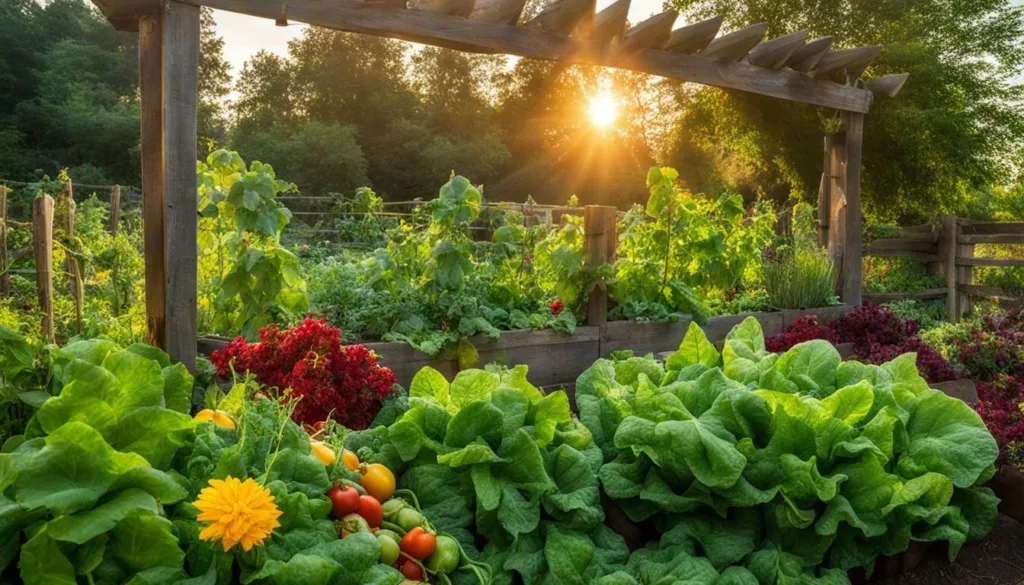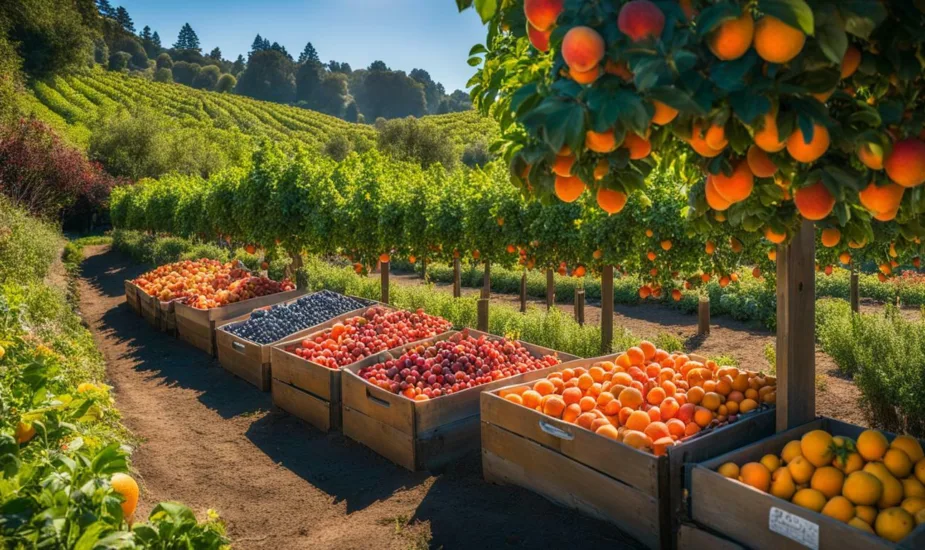Discover Simple Vegetable Fruit Gardening Ideas for Beginners
Are you interested in starting a vegetable fruit garden but unsure where to begin? Look no further than these simple vegetable fruit gardening ideas, perfect for beginners.

Discovering simple vegetable and fruit gardening ideas can be a rewarding hobby. To start, choose a sunny location with well-drained soil, and consider the size of your garden. Start small and grow what you and your family will eat. Some easy vegetables for beginners include lettuce, green beans, radishes, and tomatoes. Consider your growing zone and maximize space by using raised beds, containers, hanging planters, and vertical gardening techniques. Be mindful of the varieties of plants you choose and stagger plantings for continuous harvest. Also, consider the use of companion planting and adjust planting schedules based on your climate. Additionally, explore different types of gardens, such as square-foot gardens, backyard gardens, raised bed gardens, kitchen gardens, homestead gardens, small gardens, dry gardens, flower gardens, companion planting gardens, and partial-shade gardens. Finally, plant fruit trees in containers or use espalier techniques to train them up walls or fences, and interplant vegetables in flower gardens for added variety. Remember to plant what you will enjoy eating and have fun experimenting with different gardening ideas.
Key Takeaways:
- Start with a sunny location and well-drained soil for your vegetable fruit garden.
- Consider the size of your garden and start small with easy-to-grow vegetables like lettuce, green beans, radishes, and tomatoes.
- Maximize space by using raised beds, containers, hanging planters, and vertical gardening techniques.
- Stagger plantings and choose varieties suitable for your climate for a continuous harvest.
- Explore different types of gardens, such as square-foot gardens, backyard gardens, raised bed gardens, and more.
Choosing the Right Vegetables for Your Garden
When it comes to vegetable fruit gardening, choosing the right vegetables is crucial. Let’s explore some easy options for beginners and discover the benefits of organic gardening.
List of Easy Vegetables for Beginners:
- Lettuce
- Green beans
- Radishes
- Tomatoes
These vegetables are not only simple to grow but also versatile in the kitchen, making them ideal choices for beginners. They require minimal maintenance and provide a bountiful harvest, ensuring a rewarding gardening experience.
Organic gardening is also gaining popularity due to its numerous benefits. By avoiding synthetic chemicals and pesticides, organic gardeners can enjoy pesticide-free produce that is healthier and safer for consumption. Organic gardening promotes biodiversity, helps protect the environment, and supports natural ecosystems, making it a sustainable choice.
Benefits of Organic Gardening
Quote: “Organic gardening allows me to have full control over what I put into my body. I enjoy the peace of mind knowing that my fruits and vegetables are free from harmful chemicals.” – Jane Doe, avid organic gardener
Organic gardening not only benefits your health but also contributes to the well-being of the planet. By nurturing the soil with organic matter and using natural pest control methods, you can create a harmonious ecosystem that supports plant growth and attracts beneficial insects.
By choosing easy vegetables for your garden and embracing organic gardening practices, you can cultivate a thriving vegetable fruit garden that provides you with fresh, healthy produce throughout the season. So grab your gardening tools and embark on this exciting journey today!

Don’t let limited space hinder your vegetable fruit gardening dreams. Learn how to maximize every inch of your garden with these space-saving techniques. Whether you have a small backyard, an urban balcony, or just want to make the most of the available space, there are plenty of options to grow a bountiful garden.
One option is container vegetable fruit gardening, which allows you to grow plants in pots, buckets, or even recycled containers. Not only does this save space, but it also gives you the flexibility to move your plants around to take advantage of sunlight or protect them from inclement weather. Plus, you can create a visually appealing display by choosing containers in different sizes and colors.
Another space-saving technique is vertical gardening. This technique involves growing plants vertically rather than horizontally, using trellises, stakes, or hanging baskets. By training plants to grow up instead of spreading out, you can save valuable ground space. This is particularly useful for vining vegetables like cucumbers and beans, or for growing herbs and flowers.
If you have limited ground space, consider creating a small space vegetable fruit garden using raised beds. Raised beds allow you to grow plants in a concentrated area and provide better control over soil conditions. They also help prevent weeds and make gardening more accessible by reducing the need for bending or kneeling. Raised beds can be built with a variety of materials, such as wood, cinder blocks, or recycled materials.
With these space-saving techniques, you can transform even the smallest of spaces into a thriving vegetable fruit garden. Remember to choose plants that are suitable for your growing zone, and consider companion planting to maximize productivity and protect plants from pests. With a little creativity and careful planning, you’ll be amazed at what you can achieve in your small space garden.

Want to enjoy a continuous harvest from your vegetable fruit garden? Follow these quick hacks and low-maintenance tips to ensure a steady supply of fresh, homegrown produce.
- Choose the right plant varieties: Opt for vegetables and fruits that have a shorter maturity period. Look for varieties labeled as “early” or “quick-growing.” These plants will reach maturity faster, allowing you to harvest and replant sooner.
- Stagger your plantings: Instead of sowing all your seeds at once, stagger your plantings by sowing a small batch every couple of weeks. This way, you’ll have a continuous supply of vegetables and fruits ripening at different times throughout the season.
- Practice succession planting: As you harvest your crops, immediately replant the vacant spaces with new seeds or transplants. This technique ensures that your garden remains productive and maximizes the use of available space.
- Implement companion planting: Certain plant combinations can benefit each other by deterring pests, enhancing pollination, and maximizing space. For example, interplanting herbs like basil with tomatoes can improve tomato flavor and repel insects.
- Utilize season extenders: To extend your growing season, consider using row covers, cloches, or cold frames. These structures protect your plants from frost and cold temperatures, allowing you to continue harvesting well into fall or even winter.
Example of Staggered Planting Schedule
Here’s an example of a staggered planting schedule for lettuce:
| Planting Date | Harvest Date |
|---|---|
| April 1st | May 15th |
| April 15th | June 1st |
| May 1st | June 15th |
| May 15th | July 1st |
By following these tips, you can enjoy a continuous harvest from your vegetable fruit garden without excessive effort. Incorporate these practices into your gardening routine and savor the joy of freshly harvested produce throughout the growing season.

Vegetable fruit gardening offers a world of possibilities. Explore different types of gardens, from sustainable practices to companion planting, and discover which is the right choice for you.
When it comes to sustainable vegetable fruit gardening, environmentally friendly practices are at the forefront. This type of gardening focuses on reducing waste, conserving resources, and promoting biodiversity. You can incorporate composting, rainwater harvesting, and natural pest control methods to create a sustainable ecosystem in your garden. By following these principles, you not only contribute to a healthier planet but also reap the benefits of growing your own organic fruits and vegetables.
Companion planting gardens are another popular choice for vegetable fruit gardening enthusiasts. This method involves planting different crops together that benefit each other in various ways. For example, planting marigolds alongside tomatoes can help deter pests, while growing basil near peppers can enhance their flavor. By carefully selecting compatible plants, you can create a natural balance that promotes growth, improves soil health, and reduces the need for chemical pesticides.
| Garden Type | Description |
|---|---|
| Companion Planting Gardens | Planting different crops together that benefit each other in various ways. |
| Partial-Shade Gardens | Optimal for vegetables and fruits that thrive in less sunlight. |
| Sustainable Gardens | Environmentally friendly practices that reduce waste and promote biodiversity. |
For those dealing with partial-shade areas in their gardens, partial-shade gardens are an ideal choice. This type of garden is suitable for growing vegetables and fruits that thrive in less sunlight. Leafy greens like lettuce and spinach, as well as crops such as broccoli and cauliflower, can be successfully cultivated in these conditions. By carefully selecting the right plants, you can make the most of the available sunlight and achieve a bountiful harvest in your partially shaded garden.
Explore the Possibilities
Vegetable fruit gardening is a dynamic and versatile hobby that offers endless opportunities for creativity and experimentation. Whether you opt for sustainable gardening practices, companion planting gardens, or partial-shade gardens, each approach has its unique benefits and challenges. Consider your own gardening goals, available space, and personal preferences to determine which type of garden is the right fit for you. Remember, the key is to have fun and enjoy the process of nurturing your own homegrown fruits and vegetables.

Take your vegetable fruit garden to the next level by incorporating fruit trees and interplanting techniques. Let’s explore how to make the most of limited space while enjoying a diverse garden.
When it comes to small space vegetable fruit gardening, fruit trees may seem like a challenge due to their size. However, you can still enjoy the benefits of fresh fruits by planting them in containers or utilizing espalier techniques to train them up walls or fences. This not only saves space but also adds a beautiful element to your garden. Choose dwarf or semi-dwarf varieties of fruit trees, such as apple, pear, or citrus, as they are more suitable for small gardens.

In addition to fruit trees, interplanting can be a great way to maximize space and increase the variety of crops in your garden. By planting vegetables in the same bed as flowers, you create a harmonious combination that not only adds visual appeal but also attracts beneficial insects and pollinators. For example, planting herbs like basil or dill alongside tomatoes can help repel pests and improve the flavors of your tomatoes.
Consider creating a dedicated flower garden within your vegetable fruit garden, where you can grow blooming plants like marigolds, calendula, or nasturtiums. These flowers not only add color and beauty but also help attract beneficial insects and deter pests. By strategically placing flowering plants throughout your garden, you create a welcoming environment for bees, butterflies, and other pollinators, which is essential for fruiting plants.
By incorporating fruit trees and interplanting techniques in your vegetable fruit garden, you can make the most of your limited space while enjoying a diverse range of crops. The combination of edible fruits and blooming flowers creates a visually appealing and productive garden that will delight both your eyes and your taste buds.
Conclusion
Simple vegetable fruit gardening ideas can transform your backyard into a vibrant oasis and provide a source of fresh, homegrown produce. Start your gardening journey today and discover the joys of growing your own food.
When venturing into vegetable fruit gardening, it’s important to choose a sunny location with well-drained soil. Starting small and growing what you and your family will eat is key. Some easy vegetables for beginners include lettuce, green beans, radishes, and tomatoes.
Maximize space in your garden by utilizing raised beds, containers, hanging planters, and vertical gardening techniques. Stagger plantings and choose plant varieties wisely to ensure a continuous harvest. Consider companion planting and adjust planting schedules based on your climate for optimal results.
Explore different types of gardens to suit your preferences and needs. From square-foot gardens to kitchen gardens, there are various options to choose from. Incorporate fruit trees into your vegetable fruit garden by planting them in containers or using espalier techniques to save space. Interplanting vegetables in flower gardens adds an extra touch of variety.
Remember, the key is to plant what you will enjoy eating and have fun experimenting with different gardening ideas. So go ahead, dig in, and experience the satisfaction of growing your own delicious, homegrown produce.
FAQ
Q: What are some easy vegetables for beginners to grow?
A: Lettuce, green beans, radishes, and tomatoes are all great options for beginners.
Q: How can I maximize space in my vegetable fruit garden?
A: You can maximize space by using raised beds, containers, hanging planters, and vertical gardening techniques.
Q: What are some tips for achieving a continuous harvest?
A: Choose plant varieties wisely and stagger plantings to ensure a steady supply of fresh produce.
Q: What types of vegetable fruit gardens can I explore?
A: Consider square-foot gardens, raised bed gardens, kitchen gardens, small gardens, or even companion planting gardens.
Q: How can I incorporate fruit trees into my vegetable fruit garden?
A: Plant fruit trees in containers or use espalier techniques to save space.
Q: Can I interplant vegetables in flower gardens?
A: Yes! Interplanting vegetables in flower gardens can add variety and beauty to your garden.
Q: Why is it important to choose simple vegetable fruit gardening ideas?
A: Choosing simple gardening ideas ensures a rewarding and enjoyable gardening experience.
 Little Garden Tips
Little Garden Tips







